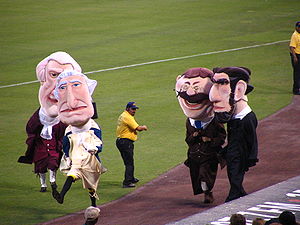APOD wrote:The historic site features enormous sculptures of four US presidents; George Washington, Thomas Jefferson, Theodore Roosevelt and Abraham Lincoln, carved into the southeast face of granite cliffs.

http://en.wikipedia.org/wiki/Presidents_Race
---
http://www.wired.com/science/discoveries/news/2007/07/dayintech_0704 wrote:1054: A supernova noted by Chinese observers heralds the creation of the Crab Nebula. The exact date has been disputed, but most accounts accept the Chinese date of July 4.
So is that the Chinese calendar converted to Julian or the Chinese calendar converted to Gregorian?http://deep-space-astronomy.suite101.com/article.cfm/the_crab_nebula_supernova_1054_ad wrote:The Biggest July 4 Fireworks Explosion in History Formed M1 ... According to Chinese records, on July 4, 1054 AD a very bright guest star appeared, at the current position of the Crab Nebula. It was close to the star, Zeta Tauri. At its peak this guest star was visible in the daytime for a period of 23 days. It slowly faded and disappeared from view altogether in the spring of 1056, nearly two years later.
---
APOD wrote:Most noticeable are the stars of Ursa Major and the asterism known as the Big Dipper, almost resting upright along the cliff edge near picture center.
neufer ([url=http://asterisk.apod.com/viewtopic.php?p=107444#p107444]here[/url]) wrote:Vincent van Gogh's Starry Night Over the Rhone, painted in September 1888 at Arles, depicts the Rhône River at night.
---Case ([url=http://asterisk.apod.com/viewtopic.php?p=107474#p107474]here[/url]) wrote:This painting is a view to the south, where Vincent took the liberty to place the Big Dipper there in the sky, where he could never have seen it like that, as Ursa Major is roughly towards the north.
They don't point as close to Polaris in this flat picture as they do in the round sky.APOD wrote:a line extending through the dipper's two [rightmost] stars points to the upper right toward Polaris

